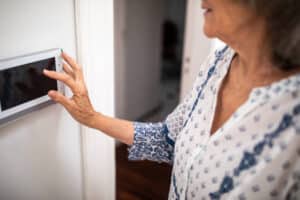
As more seniors choose to age in place or live independently, safety becomes a top priority for families and caregivers. The right home security system can provide peace of mind, enhance safety, and offer real-time alerts in emergencies. But one of the most common questions that arises is about the cost. Whether you’re comparing monthly monitoring fees or wondering about upfront installation charges, understanding the cost of installing a home security system is essential for making an informed decision.
Why Home Security Matters More for Seniors
For older adults, even a minor home incident can quickly become a serious situation. A slip near the front door or an unexpected visitor could have significant consequences. That’s why many families are turning to home security systems as part of their broader aging-in-place strategy. These systems can include door and window sensors, motion detectors, surveillance cameras, medical alert integrations, and smart locks, all of which work together to create a safer living environment.
Security systems not only prevent potential break-ins but also help monitor daily patterns. Some systems can alert caregivers if there’s unusual activity—or a lack thereof—during certain hours. In essence, they function as both a safety net and a means of maintaining independence. For seniors who value autonomy, this blend of protection and freedom can be priceless.
What Does a Home Security System Typically Cost?
When budgeting for a system, it’s essential to consider both upfront and ongoing costs. The initial investment usually includes hardware and installation fees. Depending on the provider and equipment needed, this can range from a few hundred to over a thousand dollars. Features such as wireless sensors, video doorbells, and environmental detectors (for smoke, carbon monoxide, or water leaks) can add to the base cost but also offer more comprehensive protection.
Monthly monitoring is another key expense. Professional monitoring services, where trained agents respond to alerts and contact emergency services when necessary, typically range between $10 and $50 per month. This recurring cost is worth considering, especially for seniors who live alone and may not be able to respond quickly to alerts on their own. However, some providers offer self-monitoring options, which are less expensive but rely on the user or caregiver to take action in emergencies.
If budget is a significant factor, starting with a basic package and upgrading as needed can be an innovative approach. Some security providers allow customers to add components over time, which helps spread out costs. In any case, evaluating your needs honestly will help determine what level of investment makes the most sense.
Factors That Influence Pricing
Several variables can affect the final cost of a home security system. One major factor is whether you opt for a DIY installation or a professional setup. While DIY kits can be more affordable, they may not offer the same level of customization or reliability as professionally installed systems. Additionally, seniors with limited mobility or tech experience may find a DIY setup too challenging.
Another factor is the size of the property and the amount of coverage required. A small one-bedroom apartment will require fewer sensors and devices than a multi-story home. Seniors who live in communities with existing security features may need only a supplemental system, while those in more isolated locations might require a more robust setup.
Integration with other smart home devices—such as voice assistants, lighting, or thermostats—can also increase the price. While these extras can make daily life easier and more convenient, they are not essential for everyone. It’s wise to prioritize core safety features first and expand to convenience tools later, depending on budget and lifestyle.
Planning for Peace of Mind
Home security is not just a financial decision—it’s an emotional one. For seniors and their loved ones, knowing that help is available at the press of a button or that unusual activity will trigger an alert can bring significant peace of mind. It’s also a way to maintain dignity and independence, which are often at the heart of senior living choices.
Families should approach this decision with open communication. Discuss the seniors' priorities, preferences, and any limitations they may have with technology or mobility. Working together to choose the right system ensures everyone is on the same page and helps reduce anxiety for both seniors and caregivers.
When researching options, take the time to compare providers, read reviews, and ask questions about hidden fees or contract requirements. Many companies offer detailed cost breakdowns, and some even provide free consultations to assess your home’s unique needs. For a deeper look at pricing specifics, including equipment and monitoring expenses, refer to this helpful guide on the cost of installing a home security system.
Final Thoughts
Protecting a senior’s home is about more than locks and cameras—it’s about creating an environment that supports safety, confidence, and independence. By understanding the financial aspects of installing a home security system, families can plan more effectively and avoid unexpected expenses. With the right setup, seniors can enjoy the comfort of their homes while remaining secure, connected, and in control.